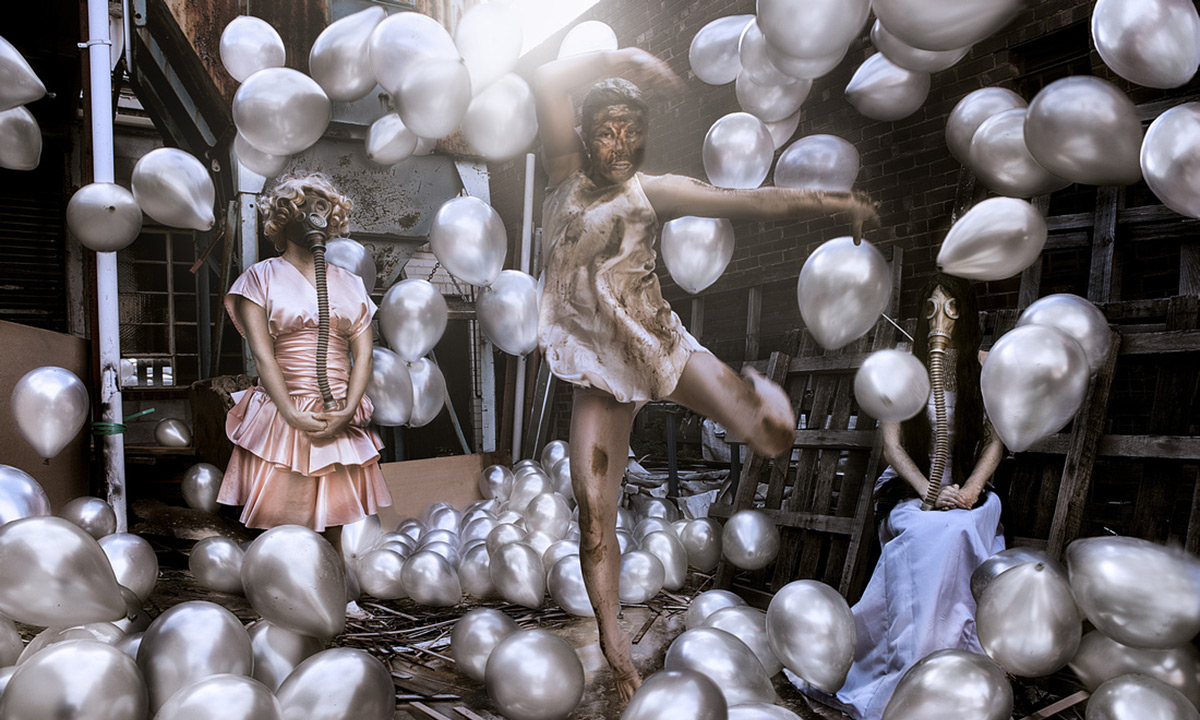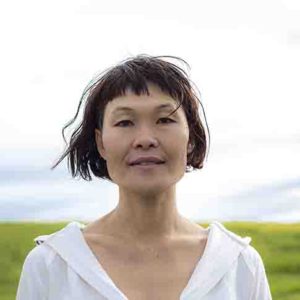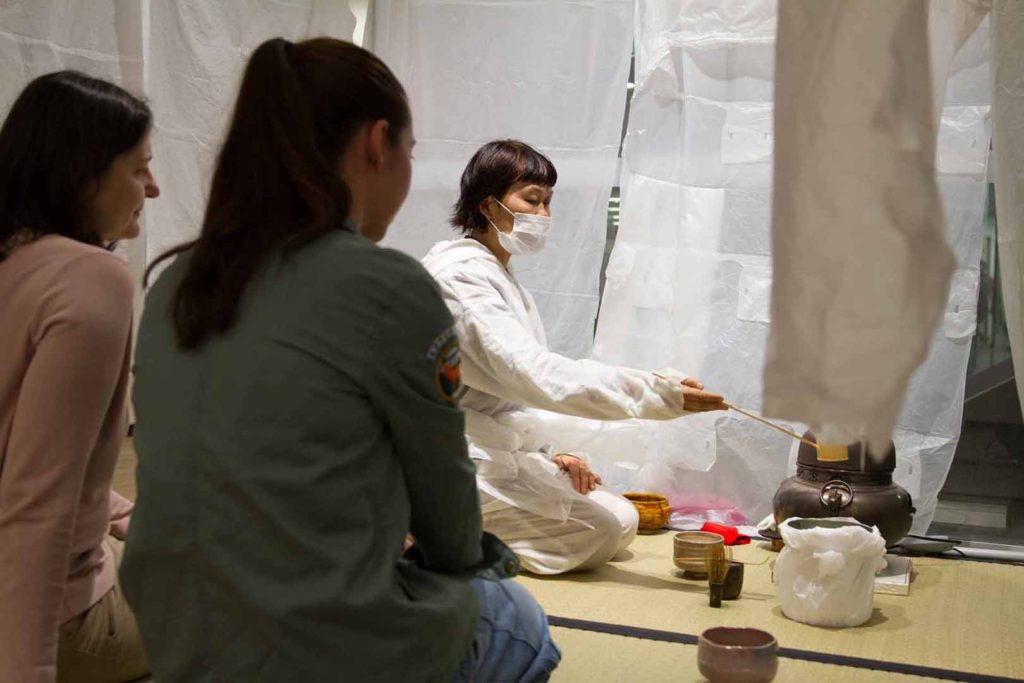
Feature
Yumi Umiumare

Interview with Yumi Umiumare
We sat and chatted with Australian-based Japanese butoh dancer and choreographer Yumi Umiumare at the Opening Reception of The Japan Foundation, Sydney’s gallery exhibition ECO-ANXIETY: Holding a Deep Breath, at which she performed her AnxieTEA Pop-up Tea Room. We found out more about her quirky mix of light and dark that is in all her work and how living in Australia has influenced her as an artist.

JPF: HOW DO YOU DESCRIBE YOUR STYLE OF PERFORMANCE ART?
Y: Well originally I performed butoh which is a Japanese contemporary dance form that originally started as a ‘dance of darkness’, so it’s a dark dance form that intrigued me but I also like the lightness. I call what I do ‘Butoh Cabaret’, so we have the dark side of butoh with cabaret elements adding the lightness. I like trying to question and provoke cultural identity through this form.
One of the main series I have done is called DasSHOKU which is a series of performances that question myself and other people about cultural stereotypes and identity while also exploring the concept of culture in general. DasSHOKU covered a number of themes, for example DasSHOKU Horror, encompassed some Japanese horrific true stories like a wife killing her husband, or a son killing his mother. It also intergrated the Japanese phrase “hora hora hora” which means “Look! look! look!” incorporating the highly visual Japanese character of Ganguro (a fashion trend of fake tans and thick makeup) which was big about 10 years ago. These girls while very fashionable and out-there were actually quite lost.
The final piece of the series was DasSHOKU Shake, based on the Japanese earthquake and one of my main DasSHOKU pieces which toured with the Japanese Theatre Group. The piece explored not just the physical ‘shaking’ of the land but also the human psyche ‘shake’ that took place. For me it was an interesting area, that through the earthquake, questions of identity and people’s beliefs were ‘shaken up’. I like working with this darkness but make it light for the contrast. I am drawn to working within that contrast, and collaborating with the Japanese Theatre Group was interesting as they are very comedic, incorporating various puns like the “hand-shake” and “milk-shake”.

JPF: YOU HAVE BEEN A PART OF A NUMBER OF FANTASTIC PROJECTS WITH VARIOUS GROUPS INCLUDING REFUGEES, PEOPLE WITH DISABILITIES AND ABORIGINAL COMMUNITIES. HOW DID THOSE OPPORTUNITIES COME ABOUT?
Y: I have been here for long enough to have worked on an off with a lot of various people. So I sometimes get asked to be a part of various projects and choreograph for them, which has taken me across to Broome and Central Australia. My work with Indigenous communities was through a company called Big hART who was looking for a Japanese choreographer, which brought them to me. That’s how we started. We worked with many Indigenous communities. The theatre directors I began working more with were doing a lot of social engagement work and working with groups including asylum seeker, people recovering from gambling addictions, and even trafficked sex workers. So, these were some very big social issues, for which I was called in to be a choreographer.

JFP: HOW DID YOU FIND YOUR PERFORMANCE STYLE CONTRIBUTED TO THESE PROJECTS AND THE PARTICIPANTS? LIKEWISE, DID THESE PROJECTS HAVE ANY IMPACT ON YOU AS AN ARTIST?
I am not scared to be technical but I don’t want to be restricted by set technical ways.
Y: My style is not counting 1-2-3-4, but more about the body and how to draw out that sense of darkness – which is where the butoh element is relevant. What we did was not specifically classic butoh, but as the participants had been through their own dark difficulties, I interpreted this as a universal interpretation of butoh also. I am not scared to be technical but I don’t want to be restricted by set technical ways. I call it body-specific, as people have got their own quality that I don’t want to lose, so the important part is to use their inner ability rather than try to impose anything on them. I found this offered the Indigenous community an alternative way of expressing themselves.
When working with professional theatre people we often create an abstract fictional theatre world, but with my work with the Indigenous community participants we had real people expressing real things – which was really powerful. It had me questioning what is theatre even for: is it for a fake fiction world or for making sense of the real world with real people and their true sufferings? I felt quite lucky to be involved with that for the last five years.
JPF: TODAY YOU ARE AT THE JAPAN FOUNDATION IN SYDNEY ABOUT TO PERFORM YOUR ‘POP-UP TEA ROOM’ AT THE OPENING RECEPTION FOR THE ECO-ANXIETY EXHIBITION, WHICH IS A PART OF THE BIG ANXIETY – A FESTIVAL OF ARTS, SCIENCE AND PEOPLE. HOW DID THIS PROJECT COME ABOUT?
Y: I was lucky enough a couple of years ago to receive an Australian Council fellowship for new work production and they asked me if I was doing anything new and I thought ‘Tea!’. So this was a completely new thing for me, but all of a sudden my pop-up tea room started as the new project.
I think originally it was born out of a desperate artist needing funding situation, starting out with the stereotypical Japanese tea concept. But I was inspired by a tea ceremony teacher of mine who happened to be an Australian living in Melbourne at that time. His style was never overly conservative, capturing the spirit of tea, which is actually quite avant-garde. But the tea ceremony is a centuries old physical art form which is very holistic and meditative. I thought that the twisted and bent part of history that is woven into tea ceremony (samurai having tea before the go to war and be killed) would mix well with butoh as they’re both a bit twisted. Also in the tea ceremony they have a very interesting word called ‘mitate’ which is ‘pretend to be’ so while it is a really traditional art form you can utilise other objects or leftover materials from everyday life and transform them into something else altogether. So there are many playful, subtle elements.

JPF: HOW DOES THIS DIFFER TO YOUR PREVIOUS WORK?
Y: I am usually very physical and open, but this has been a quieter, more subtle performance style for me. I will still go back again to the big style theatre, but I enjoy the interactions and also the connections made to mental health, and talking about anxiety. People need a little relief – some mental relief. This is how tea ceremony started out in the war zone as a kind of place to take pause and contemplate life. Traditionally there is also a small door you would need to go through, which made you bend down and be humble as opposed to charging into a room as we might normally. So I joke about how my tea room participants have to take their mobile phone out before entering my room. In a way, everyone today is in a war zone of technology.
JPF: HAVE YOU FELT YOUR STYLE AND PROCESSES HAVE CHANGED AS AN ARTIST? DOES BEING IN AUSTRALIA HAVE ANYTHING TO DO WITH THAT?
Y: Yes certainly, especially in Melbourne, being a bit of a comedy capital. I came from Osaka originally, which has that similar lightness. So I like that sense of lightness and little bit of openness in Australia. A good example is from two years ago when I was invited to the Butoh International Festival in Germany with 75 other people from all over the world. I was one of the choreographers and there were a bunch of people from Europe who knew a lot about butoh but I particularly noticed that the group of Aussies that had come were very free form while still capturing the essence of butoh. I think the Australian sense of space plays an influence. This has its good and bad sides. Because it could contribute to being too loose and careless, but the other part is very open and unconventional. The thinking is not too confined or restricted, which has definitely influenced me as an artist.
Also, looking back at my DasSHOKU work, I initially wanted to do something crazy but now I question is it being crazy just for the sake of it or do we need to explore the reality of life, the truth and authenticity in life. So perhaps I have matured in that sense.
Recent works with Japanese organisation and theatre groups remind me of identity and how Japanese people work so hard which amazes me. I am torn between Japan and Australia so can feel both ways. I recently did some cultural coordination work in Japan with the Japanese Contemporary Dance Network which was a dance film project between Japan and Australia. I call myself a cultural transformer – connecting, building, and adjusting temperatures.
JPF: WHAT ADVICE WOULD YOU HAVE FOR ASPIRING PERFORMING ARTISTS?
Y: Don’t get overwhelmed with what you see online on Youtube, social media or other platforms. It can be so easy to compare yourself to so many things. You have to focus on pursuing what is true to you, not trying to keep up and match others. Do what gives you that “waku waku” feeling – that thrill. So it can’t just be for success or fame but something that deeply excites you. And if you pursue that more will follow. If you just follow somebody else’s idea or style, it’s not going to last – especially in the arts.
I was lucky enough to be able to keep having fun. I mean, it can still be difficult but at least I have felt something strong – real excitement and worth. But the hard work can exhaust you. Three or four years ago I was feeling quite fed up and questioning if I could keep doing it, and then I got a fellowship. If you are feeling stuck just take a detour. You don’t have to be product orientated all the time. Look for collaborations because when you are constantly creating product after product you can just consume yourself and get lost a little in the game. In that sense it can be difficult.
JFP: WHAT IS NEXT FOR YUMI UMIUMARE?
Y: I am currently creating a new solo work called Tea Break – encompassing the tea component again. I have already started on the dance component and will now add other visual components. Then in the next year or so I will create a physical theatre piece with a mix of butoh, spoken word, and a little bit of tea interactions, exploring that we all need a tea break, but also incorporating the tea “breaking”. So there’s that contrast of light and dark again!
